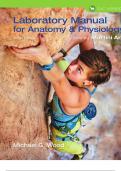, C a t Ve r s i o
Laboratory Manual
for Anatomy & Physiology
Sixth Edition featuring Martini Ar
Michael G. Wood
with
William C. Ober, M.D.
Art Coordinator and Illustrator
Claire W. Garrison, R.N.
Illustrator
Ralph T. Hutchings
Biomedical Photographer
Shawn Miller
Organ and Animal Dissector
Mark Nielsen
Organ and Animal Dissection Photographer
A01_WOOD0187_06_SE_FM_CAT.indd 1 09
,
, Preface
This laboratory manual is designed to serve the lab course that student learning. A general introduction to the exercise g
accompanies the two-semester anatomy and physiology lec- students a preview of what they are about to learn; then in
ture course. It provides students with comprehensive coverage vidual activities focus on more specific study. The activities
of anatomy and physiology, beautiful full-color art and photo- self-contained, and instructors may easily assign only cer
graphs, and an intuitive pedagogical framework. The primary activities within an exercise.
goals of this manual are to provide students with hands-on Each Lab Activity section first introduces the activity
experiences that reinforce the information they learn in the reviews the concepts necessary for understanding it. These
lecture course and to help them understand three-dimensional followed by two or three QuickCheck Questions that stude
relationships, visualize complex structures, and comprehend can use to gauge their comprehension of the material be
intricate physiological processes. proceeding. The activity itself begins with a clearly marked
The manual is written to correspond to all current two- of Materials and the Procedures for carrying it out. Featu
semester anatomy and physiology textbooks, although those such as Clinical Application boxes, Study Tip boxes, Draw
students and instructors using Fundamentals of Anatomy & Phys- activities, and Make a Prediction questions provide stude
iology, Tenth Edition, by Frederic H. Martini, Judi L. Nath, and with meaningful context and additional practice and rev
Edwin F. Bartholomew will recognize here some of the superb as they complete each activity. Each exercise concludes wit
art from that text by William Ober and Claire Garrison, Mar- Review & Practice Sheet, which includes data reporting, rev
tini’s renowned biomedical illustrators. questions, and labeling and drawing activities to assess and
This sixth edition manual is available in three separate ver- inforce student learning.
sions. The Main Version covers the full two-semester A&P cur-
riculum, including dissections of the cow eye and of the sheep Cat and Pig Dissection Exercises
heart, brain, and kidney. The Cat Version includes all of the Dissection gives students perspective on the texture, scale,
same material plus an additional section of nine cat dissec- relationships of anatomy. For those instructors who choos
tion exercises encompassing the major body systems. The Pig teach dissection in their laboratories, this manual is availa
Version, similarly, includes all of the material from the Main in two dissection versions, the Cat Version and the Pig Versi
Version with a separate section of nine fetal pig dissection ex- featuring sections at the back of the manual detailing the
ercises. The Cat and Pig Versions make the manual more useful section of the cat or fetal pig. Included are nine exercises
to instructors whose students perform animal dissections in progress through the major body systems, with the goal of
the lab. The outstanding dissections and accompanying photo- lating these exercises to students’ study of the human bo
graphs are by Shawn Miller and Mark Neilsen and I thank each Safety guidelines and disposal methods are incorporated i
of them for their expertise. each dissection exercise.
Organization BIOPAC® Activities
The lab manual contains 47 exercises, plus the 9 additional Beginning with the second edition, this manual has featu
dissection exercises in each of the Cat and Pig Versions. Large exercises using the BIOPAC Student Lab System, an integra
systems, such as the skeletal, muscular, and nervous systems, suite of hardware and software that provides students w
appear across several exercises, the first serving as an overview powerful tools for studies in physiology. BIOPAC is used
exercise that introduces the major anatomical organization of Exercises 22, 23, 30, 37, and 40, and can be easily identi
the system. Programs with limited lab time might choose the by the BIOPAC logo to the left of the activity title. All of th
overview exercises for a hands-on summary of these organ sys- BIOPAC activities feature step-by-step instructions, full-co
tems that can be completed during a short lab period. art, and instructive screenshots to walk students through
procedures. The instructions in this lab manual are for
Exercise Organization with the BIOPAC MP36 (or MP35/30) data acquisition u
Each exercise is organized into a series of Lab Activities that and Biopac Student Lab (BSL) Software version 3.7.5 or be
divide the material into natural sets of information to focus Instructions for use of the new two-channel data acquisit
students on related concepts. Every exercise begins with a unit, the MP45, can be found in the Instructor Resource
list of the Lab Activities and a set of Learning Outcomes for MasteringA&P (masteringaandp.com).
A01_WOOD0187_06_SE_FM_CAT.indd 3 09




